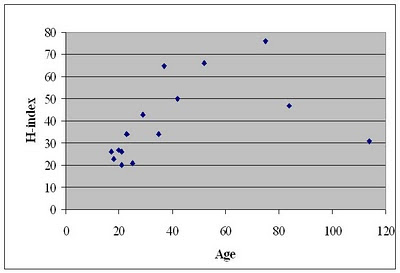 Gary Feinman asked me about how the Journal ranking I showed (by H-index) related to journal age. Obviously the longer a journal is in existence, the greater the number of its articles that will be cited, and the more times they will be cited. So I added an "age" column to the table, and plotted the data. It is clear that age is a major determinant of h-index for these journals (and this is probably one reason why H-index is not the best measure of journal impact).
Gary Feinman asked me about how the Journal ranking I showed (by H-index) related to journal age. Obviously the longer a journal is in existence, the greater the number of its articles that will be cited, and the more times they will be cited. So I added an "age" column to the table, and plotted the data. It is clear that age is a major determinant of h-index for these journals (and this is probably one reason why H-index is not the best measure of journal impact).| Journal | H-index | Age |
| American Antiquity | 76 | 75 |
| Radiocarbon | 66 | 52 |
| Jr. Archaeological Science | 65 | 37 |
| World Archaeology | 50 | 42 |
| Antiquity | 47 | 84 |
| Jr. Anthropological Arch | 43 | 29 |
| Journal of Field Arch. | 34 | 35 |
| Jr. World Prehistory | 34 | 23 |
| American Jr. Archaeology | 31 | 114 |
| Cambridge Archaeolog. Jr. | 27 | 20 |
| Jr. Arch Method & Theory | 26 | 17 |
| Latin American Antiquity | 26 | 21 |
| Jr. Archaeological Research | 23 | 18 |
| Geoarchaeology | 21 | 25 |
| Ancient Mesoamerica | 20 | 21 |
| American Anthropologist | 128 | 112 |
| Current Anthropology | 109 | 51 |
| Annual Review Anthropology | 94 | 39 |
3 comments:
also the number of articles per issue or year can make a huge difference
Is there a way to restrict the time frame to only articles published in the 90s, for example?
Thank you for illustrating this relationship.
Both earlier comments also make excellent points.
Gary
Post a Comment